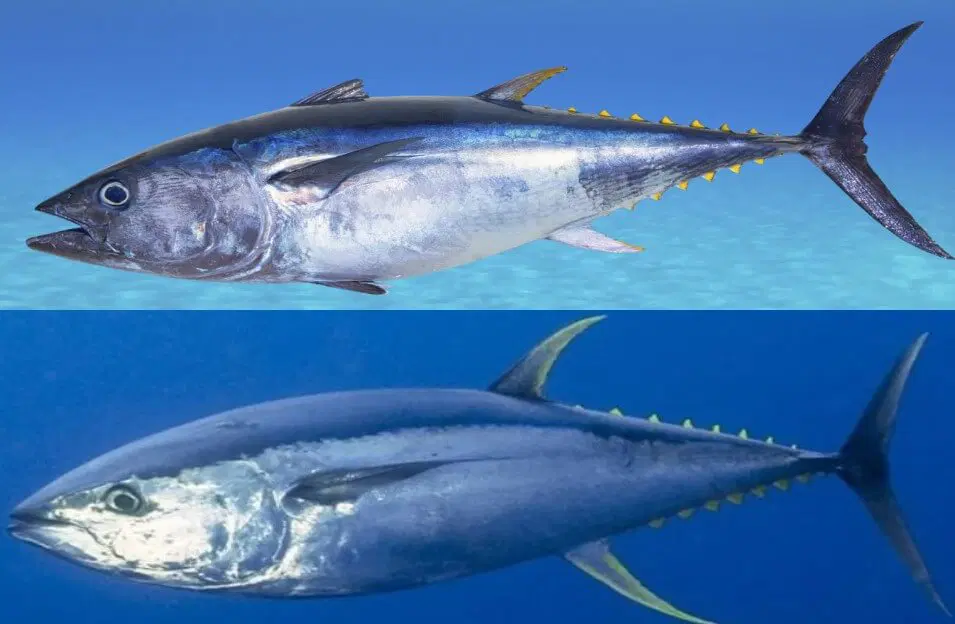Overview of Bluefin tuna consumption, habitat, life and history of human consumption & Difference between the bluefintuna and the yellowfin tuna


Bluefin Tuna – Tuna with the Highest Market Value
Among the various species of tuna, bluefin tuna have the highest market value. The bluefin tuna have the highest market value because of their rich flavor and high oily content.
Other tuna species are rather lean and have less oily contents while the bluefin tuna is highly oily and thus gives a distinctive unique flavor with a kick.


There are three distinctive species within the bluefin tuna, the Atlantic bluefin tuna, Pacific bluefin tuna and the Southern bluefin tuna.
The largest tuna species are the bluefin tuna as well as the most expensive.
The Ihchiban Maguro(一番マグロ) that means the number one tuna that marks the highest tuna value of the new Years auction in the Japan sea market is notably the tuna with the highest price of the year.


General differences between bluefin tuna and the yellowfin tuna
Difference Between Bluefin Tunan and yellowfin Tuna 1. Tuna body – yellow line
Both bluefin tuna and yellowfin tuna have a silver colored body and have some yellow patterns. However the yellowfin tuna has a more distinctive yellow colored line on its body.


Difference Between Bluefin Tunan and yellowfin Tuna 2. Tuna tail color
The bluefin tuna have a rather dark blue colored tail while the yellowfin tuna have a more yellow-grey colored tail.


Difference Between Bluefin Tunan and yellowfin Tuna 3. Pectoral fin lengths
The pectoral fins of the bluefin tuna are relatively shorter and the length of the pectoral fins(the side fins) are shorter than the second dorsal fin(fin on the back)
However, yellowfin tuna have longer pectoral fins(side fins) that usually reach to an extent to the second dorsal fin(back fin) or longer.


Difference Between Bluefin Tunan and yellowfin Tuna 4. Color of the fins
Bluefin tuna have a yellow and blue color mixed dorsal and ventral fins. The yellowfin tuna have bright, yellow-colored fins

Difference Between Bluefin Tunan and yellowfin Tuna 5. Lengths of the second dorsal(back) and ventral (belly)fins
The second fins for both the dorsal(back) and the ventral(belly)fins of blue fin tuna aren’t drastically larger than the first fins.
However, the second dorsal and ventral fins of yellowfin tuna are drastically larger and longer than the first fins.

Habitat of the Bluefin tuna
The Southern bluefin tuna earned its name as it usually lives in the Southern hemisphere while the Pacific bluefin tuna is usually found in the Pacific Ocean in the Northern hemisphere and the Atlantic bluefin tuna is found usually in the Atlantic Ocean and the Mediterranean Sea.
However, the bluefin tuna species are all migratory and their habitats aren’t strictly limited to their usual habitats.

Bluefin tuna prefer warmer temperature oceans especially for their spawning seasons. However Bluefin tuna are homothermal(warmblooded, endothermic) so they can maintain their own body temperature, thus they could even live in colder water.
Thus they are even found in cold waters and even discovered migrating in the Arctic oceans.


Biology and life of Bluefin Tuna
Bluefin tuna are migratory fish and would spend their lives traveling all around the world in schools which means they would mass up and travel together.
As bluefin tuna are highly migratory it is difficult to study them. However evidence show that bluefin tuna usually spawn their eggs in spring to Summer where they would lay 10 million eggs at once.




They would feed on any kind of sea creature smaller than them and it takes about 8 years for them to sexually mature.
The average life span of a bluefin tuna is estimated to be about 20 years but there are reports of those that lived about 50 years. Bluefin tuna could reach a swimming speed at 70~90km /h.



Stories of classification of the Atlantic Bluefin Tuna - Thunnus thynnus
Originally all bluefin tuna were classified as one species as the Thunnus thynnus. However studies suggested that the bluefin tuna should be split into several species and the Atlantic bluefin tuna became the most representative species of the bluefin tuna as it has the longest history with humans.
Although east Asia countries like Japan consume almost 80% of the bluefin tuna, Japan’s tuna consumption history is short as it started in the 1900’s.


The Pacific bluefin tuna are mostly the highest valued tuna in Japan. However, the Atlantic bluefin tuna was consumed in Europe, middle east and Africa before history so the Atlantic bluefin tuna has more historic records with humans.
Thus, in terms of taxonomy the Atlantic bluefin tuna kept the academic and scientific name Thunnus thynnus


History of Bluefin tuna consumption in Europe, Africa, Middle East and the Mediterranean region
Historically the regions of the Mediterranean region have the longest history of the consumption of bluefin tuna specifically the Atlantic bluefin tuna.
Egypt and Phoenicians have records of tuna consumption and possibly used the high oily contents of the tuna for their life. Greeks also enjoyed tuna as part of their cuisine where the name of the tuna derived from the Greek word Thyno(θύννος, to quickly or rush)




Tuna was a staple for Italy and Spain and Northern Arica historically. Mojama which is a cured tuna, is one of the most famous staples of tuna.
Tuna egg pouches were also cured and made as Bottargo di tonno in the Mediterranean region.



Bluefin tuna consumption in East Asia and Japan
Although bluefin tuna also migrated through Japan and East Asia, as bluefin tuna were caught in deeper waters far from the mainlands, it was impossible to ship and distribute tuna for consumption in East Asia.
The Mediterranean region had deeper waters where bluefin tuna live much closer to the mainlands so they could be processed or cured but it was impossible in East Asia.


After the advance in freezing and storage technologies in the 1950~1970’s along with the commercial success of canned tuna(although not bluefin) that started in the 1950’s the distinctive flavor with high oily contents of the bluefin tuna attracted the market of East Asia and Japan.
The demand of bluefin tuna skyrocketed in the Asia market and the East Asia region consumes almost 80~90% of the world’s bluefin tuna supply.



